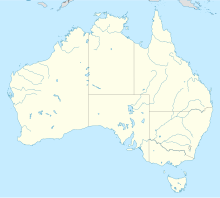Rum Jungle, Northern Territory

Browns Oxide Project entry gate
|
|
| Location | |
|---|---|
| Location | Batchelor |
| Territory | Northern Territory |
| Country | Australia |
| Coordinates | 12°59′S 131°01′E / 12.983°S 131.017°E |
| Production | |
| Products | Uranium |
| History | |
| Opened | 1950 |
| Closed | 1971 |
Rum Jungle is a locality in the Northern Territory of Australia located about 105 kilometres south of Darwin on the East Branch of the Finniss River. It is the site of a uranium deposit was found in 1949 and which has been mined.
The area derives its name from an incident when a thief stole 750 ounces of gold from miners after getting them drunk with rum.
George Goyder noted an unidentified copper-like green ore in 1869 at "Giants Reef", which was later "rediscovered" and identified to be torbernite.
In 1949, John Michael "Jack" White discovered torbernite in old nearby copper shafts.
In 1952 the Australian Government funded the setting up of a mine and treatment plant to provide uranium oxide concentrate to the UK-US Combined Development Agency under a contract which ran from 1953 to 1962. Rum Jungle was then the largest construction in the Northern Territory. The Government, through the Australian Atomic Energy Commission, was responsible for the mine, although management of it was on a contract basis by Territory Enterprises Pty Limited, a subsidiary of the Rio Tinto Group. A town called Batchelor was built 8 km south of the mine to accommodate the mining personnel. The project was officially opened in September 1954.
The Rum Jungle mine closed in April 1971 and the 200 hectare site was abandoned. The Federal Government (which controlled the mine through its agency the Australian Atomic Energy Commission (AAEC), now known as Australian Nuclear Science and Technology Organisation (ANSTO)) decided not to rehabilitate the mine site. The mining company Conzinc (now part of the Rio Tinto Group, which owns Energy Resources of Australia (ERA), operators of the Ranger Uranium Mine in Kakadu National Park) have consistently denied any responsibility for rehabilitation. This led to the mine becoming known as one of Australia's most polluted environments due to the oxidation of sulphides and the release of acid and metals into the East Branch of the Finniss River. The 1500 mm annual rainfall, along with the pyritic mineralisation in the area, created ideal conditions for such oxidation.
...
Wikipedia


